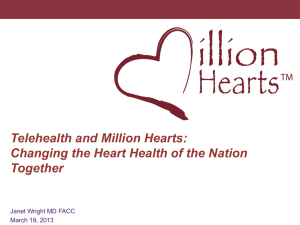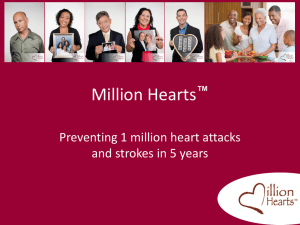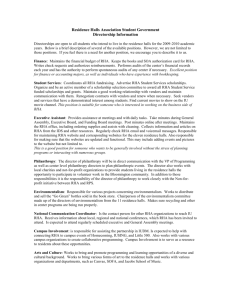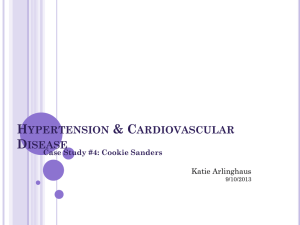Million Hearts - National Forum for Heart Disease and Stroke
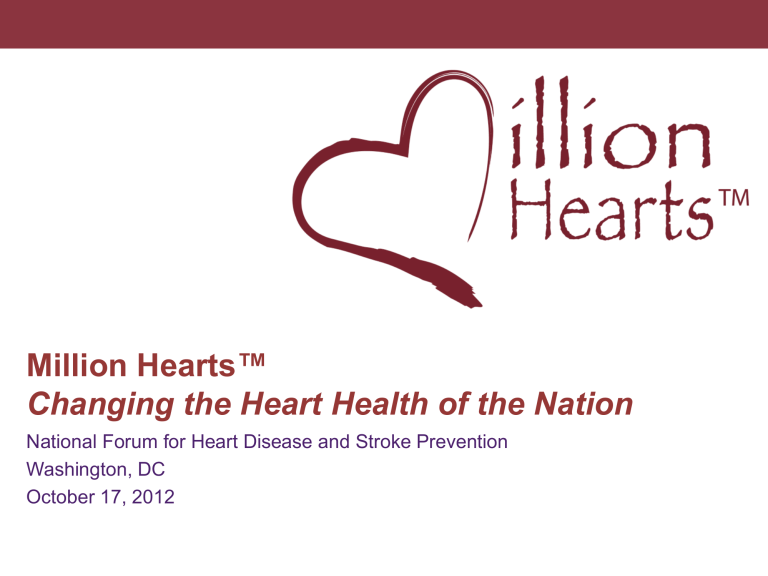
1
Million Hearts™
Changing the Heart Health of the Nation
National Forum for Heart Disease and Stroke Prevention
Washington, DC
October 17, 2012
"The National Forum for Heart Disease and
Stroke Prevention is a catalyst to drive multisector action to prevent heart disease & stroke
”
Keith C. Ferdinand, M.D., FACC, FAHA
3
Million Hearts™
Goal: Prevent 1 million heart attacks and strokes in 5 years
• National initiative co-led by CDC and CMS
• Partners across federal and state agencies and private organizations
Heart Disease and Stroke
Leading Killers in the United States
• Cause 1 of every 3 deaths
• More than 2 million heart attacks and strokes each year
– 800,000 deaths
– Leading cause of preventable death in people <65
– $444B in health care costs and lost productivity
– Treatment costs are ~$1 for every $6 spent
• Greatest contributor to racial disparities in life expectancy
Roger VL, et al. Circulation. 2012;125:e2-e220.
Heidenriech PA, et al. Circulation. 2011;123:933 –4.
A spirin
Status of the ABCS
People at increased risk of cardiovascular events who are taking aspirin
47%
B lood pressure
People with hypertension who have adequately controlled blood pressure
46%
C
S holesterol moking
People with high cholesterol who are effectively managed
33%
People trying to quit smoking who get help
23%
CDC. MMWR. 2011;60(36);1248 –51.
Key Components of Million Hearts™
CLINICAL
PREVENTION
Optimizing care
COMMUNITY
PREVENTION
Changing the context
Focus on
ABCS
Health information technology
Clinical innovations
TRANS
FAT
Community Prevention
Changing the Context: Tobacco
Comprehensive tobacco control programs work
• Graphic mass media campaign
• Smoke-free public places and workplace policies
• Free or low-cost counseling and medications
Raising the Price of Cigarettes
Through Excise Taxes Total = $6.86
Total = $5.26
Total = $4.64
Total = $3.39
Total = $1.58
Decline in Smoking in New York City, 2002 –2010
450,000 Fewer Smokers
3-yr average 3-yr average 3-yr average
NYC & NYS tax increases
Smoke-free workplaces
Free patch programs start
Hard-hitting media campaigns
NYS tax increase
Federal tax increase
NYS tax increase
New York City Community Health Survey.
Community Prevention
Changing the Context: Sodium
About 90% of Americans exceed recommended daily sodium intake
• Menu labeling requirements in chain restaurants
• Food purchasing policies to increase access to low sodium foods
• Public and professional education about the impact of excess sodium
• Publishing information on sodium consumption
CDC. MMWR. 2011;60(36);1413 –7.
Most Sodium Comes from Processed and Restaurant Foods
Realistically, people can ’ t control how much sodium they eat
Processed and restaurant foods
77%
Mattes RD, et al. J Am Coll Nutr. 1991;10:383 –93.
Fast Foods in the U.S. Are Saltier
Than in Other Countries
Dunford E, et al. CMAJ. 2012;184:1023 –8.
44% of U.S. Sodium Intake
Comes from 10 Types of Foods
Rank
1
2
7
8
9
5
6
3
4
10
Food Types
Bread and rolls
Cold cuts and cured meats
Pizza
Poultry
Soups
Sandwiches
Cheese
Pasta mixed dishes
Meat mixed dishes
Savory snacks
%
7.4
5.1
4.9
4.5
4.3
4.0
3.8
3.3
3.2
3.1
CDC. MMWR. 2012;61(Early Release):1-7.
CA
OR
Community Prevention
State Trans Fat Regulations
As of January 2012
WA
MI
OH
ME
MD
NY VT
NH
CT
MA
RI
NJ
DE
IL
TN
KY
SC
NM
MS
TX
HI
Enacted or passed trans fat regulation in food service establishments (FSEs)
Trans fat regulation in FSEs introduced, defeated, or stalled
Clinical Prevention
Optimizing Quality, Access, and Outcomes
Focus on the ABCS
• Simple, uniform set of measures
• Measures with a lifelong impact
• Data collected or extracted in the workflow of care
• Link performance to incentives
16
Clinical Prevention
Optimizing Quality, Access, and Outcomes
• Fully deploy health information technology (HIT)
• Registries for population management
• Point-of-care tools for assessment of risk for CVD
• Timely and smart clinical decision support
• Reminders and other health-reinforcing messages
17
Clinical Prevention
Optimizing Quality, Access, and Outcomes
• Innovate care delivery
• Embed ABCS and incentives in new models
– Health homes, Accountable Care Organizations, bundled payments
– Interventions that lead to healthy behaviors
• Mobilize a full complement of effective team members
– Pharmacists, cardiac rehabilitation teams
– Health coaches, lay workers, peer wellness specialists
18
CMS Programs Supporting Million Hearts™
Office of Clinical Standards and Quality
Physician Quality Reporting System
Medicare and Medicaid Electronic Health Record Incentive Program
(Meaningful Use) as drivers of core quality measures
Medicare Advantage Plan Star Ratings and Quality Bonuses
Medicare Part D Plan Star Ratings
Quality Improvement Organizations (QIO)
Part D Medication Therapy Management
Annual Wellness Visit, Health Risk Assessment, and Personalized Preventive Plan
Services
19
CMS Programs Supporting Million Hearts™
Center for Medicaid, Children ’ s Health Insurance
Program, and Survey and Certification
Medicaid Core Quality Reporting Measures
Medicaid Electronic Health Records Incentive Program
Medicaid Incentives to Prevent Chronic Disease
Medicaid Smoking Cessation Services
Medicaid Health Homes
Center for Consumer Information and Insurance
Oversight
ABCS in Essential Health Benefits
20
CMS Programs Supporting Million Hearts™
Center for Medicare and Medicaid Innovation
Test of Innovation: Promoting Adherence to Cardiovascular Medicine
Demonstration of Scale: ABCS Improvement quarter to quarter
Innovation Advisors Program “ Call for Advisors ” Tailored to ABCS and
Allied/Team-Based Care
Health Care Innovation Challenge
Medicare-Medicaid Coordinating Office
Targeted State Demonstrations and Innovations
Public-Sector Support
• Administration on Community Living
• Agency for Healthcare Research and Quality
• Centers for Disease Control and Prevention
• Centers for Medicare and Medicaid Services
• Food and Drug Administration
• Health Resources and Services Administration
• Indian Health Service
• National Heart, Lung, and Blood Institute,
National Institutes of Health
• National Prevention Strategy
• National Quality Strategy
• Office of the Assistant Secretary for Health
• Substance Abuse and Mental Health Services
Administration
• U.S. Department of Veterans Affairs
Private-Sector Support
• Academy of Nutrition and Dietetics
• Alliance for Patient Medication Safety
• America’s Health Insurance Plans
• American Academy of Nurse Practitioners
• American College of Cardiology
• American Heart Association
• American Medical Association
• American Nurses Association
• American Pharmacists’ Association and
Foundation
• Association of Black Cardiologists
• Association of Public Health Nurses
• Georgetown University School of Medicine
• Kaiser Permanente
• Medstar Health System
• National Alliance of State Pharmacy Assns
• National Committee for Quality Assurance
• National Community Pharmacists Assn
• National Consumers League
• National Forum for Heart Disease and
Stroke Prevention
• Ohio State University
• Preventive Cardiovascular Nurses
Association
• Samford McWhorter School of Pharmacy
• SUPERVALU
• UnitedHealthcare
• University of Maryland School of Pharmacy
• Walgreens
• WomenHeart
• YMCA of America
• Maryland Dept of Health and Mental Hygiene
• New York State Dept of Health
• Commonwealth of Virginia
RHA
RHA
A Network of Networks
RHA
RHA
RHA
RHA
RHA
RHA
RHA
RHA
Puerto Rico
U.S. Virgin Islands
RHA
State Node
Regional Health
Administrator
Intervention
A spirin for those at high risk
B lood pressure control
C holesterol management
S moking cessation
Getting to Goal
Baseline
47%
46%
33%
23%
Target
65%
65%
65%
65%
24
Sodium reduction
Trans fat reduction
~ 3.5 g/day 20% reduction
~ 1% of calories 50% reduction
Unpublished estimates from Prevention Impacts Simulation Model (PRISM).
Clinical target
70%
70%
70%
70%
Prevalence of Hypertension Control among
U.S. Adults with Hypertension
67 million adults with hypertension (30.4%)
(35.8M)
CDC. MMWR. 2012;61(35):703 –9.
Awareness and Treatment among Adults with Uncontrolled Hypertension
M
M
M
CDC. MMWR. 2012;61(35):703 –9.
Prevalence of Uncontrolled Hypertension, by Selected Characteristics
Yes No
Usual source of care
CDC. MMWR. 2012;61(35):703 –9.
Yes No
Health insurance
None 1 ≥2
No. times received care in past year
It Doesn ’ t Take Much to Have a BIG Impact
Small Reductions in Systolic BP Can Save Many Lives
Whelton, PK, et al. JAMA. 2002;288:1882; Stamler R, et al, Hypertension. 1991:17:I –16.
All-Cause Hospitalization Risk Declines as
Adherence Increases
Sokol MC, et al. Med Care. 2005;43(6):521 –30.
Total All-Cause Health Care Costs Decrease as
Medication Adherence Increases, Even with the
Increase in Drug Costs
Sokol MC, et al. Med Care. 2005;43(6):521 –30.
The BP Control Battle Plan
• Improve the identification of people with HTN who are not yet diagnosed
• Increase the proportion of people with HTN who are under control
• Enhance individuals ’ ability to prevent & control
HTN
• Increase measurement and reporting on HTN by healthcare systems, professionals, communities, states, and others
• Decrease the sodium intake of the population
BP Control Attack Plan
• Identify the undiagnosed
• Move the treated to controlled
• Coach self-management
• Drive measurement and reporting
• Educate and activate about high Na intake
BP Control Attack Plan
• Identify the undiagnosed 14 Million
• Move the treated to controlled
• Coach self-management
• Drive measurement and reporting
• Educate and activate about high Na intake
BP Control Attack Plan
• Identify the undiagnosed 14 Million
• Move the treated to controlled 16 Million
• Coach self-management
• Drive measurement and reporting
• Educate and activate about high Na intake
BP Control Attack Plan
• Identify the undiagnosed 14 Million
• Move the treated to controlled 16 Million
• Coach self-management 67 Million
• Drive measurement and reporting 67 Million
• Educate and activate about high Na intake 67M
Million Hearts™ Team Up. Pressure Down.
Tools
2012 Million Hearts™ BP Control Champions
Kaiser Permanente Colorado and Ellsworth Medical Clinic
2012 ICVH Driver Diagram
KP Colorado Integrated Prevention & Cardiovascular Health Driver Strategy 2012
• ICVH DRIVER DIAGRAM KPCO Million Hearts Campaign
(Prevent 1 Million MIs and strokes over next 5 years )
Population
Stratification
CAD
Major Coronary Events (MCE)
Major Cardiovascular Events-Stroke/Stoke Events (MCVE)
MIs & Procedures/Surgeries for CAD/STROKES
Rates per 100,000 members age & gender adjusted
CAD
Equivalents:
DM
PAD
CKD
Stroke/TIA
AAA
PRIMARY PREVENTION
Test the Untested
SECONDARY PREVENTION
Treat the Un-Under treated
PEDIATRIC CV RISK
Diabetes
Planned
Care
Framingham:
High >20%
Mod 11-20%
Low 5-10%
Very low <5%
CV PREVENTION
HTN Cardiology
PRE- DM
Unknown risk :
Age-
70-80
55-69
40-54
18-39
TOBACCO
EXERCISE - VITAL SIGN
Engaged Member
Children at risk
PRIMARY CARE CPS
ADULT LIFESTYLE
TERTIARY PREVENTION
Treat the Un-Under treated
Acute
Coronary
Syndrome
Mgt
Recurrent
Events
MCVE
CPCRS
Coronary
Artery
Disease
Value:
PM/PM
Avoidance:
·Hospital procedures
·Hospital costs
EMPLOYEE HEALTH
& WELLNESS
PREVENTION CARE CONTINUUM
POPULATION AND PREVENTION SERVICES (CARE COORDINATORS, CPCRS, DISEASE MANAGEMENT TEAMS)
Smoking Cessation
Evidence Based Treatment Strategies with Engaged Integrated Teams
TLC-Diet Phys Activity Chol Mgt BP Control Glucose Depression hsCRP Statins Creat Beta Blocker
Healthy Communities
Healthy Schools Live Well Heart & Stroke Healthy Communities Community Benefit
ACE/ARB ASA
3.8.12
Ellsworth Team Million Hearts™
Million Hearts™ Will Mean…
Needs and Seeds
Prevention, Detection, Treatment, Control
• Awareness of performance gaps and actions
• Skills to measure, analyze, improve
• A blanket of BP monitors
• Standardized protocol or algorithm
• Timely, low-cost loop of measurement and advice
• Effective team care models
• Access and persistence to meds
• Business case
The Future State
Adding web-based pharmacist care to home blood pressure monitoring increases control by >50%
• Lower sodium foods are abundant and inexpensive
• BP monitoring starts at home and ends with control
• Data flows seamlessly between settings
• Professional advice when, where, how, and from whom it is most effective
• No or low co-pays for medications
• High performance on BP control is rewarded
Green BB, et al. JAMA .2008;299:2857 –67.
Resources
• Vital Signs: Where ’ s the Sodium?
www.cdc.gov/VitalSigns/Sodium/index.html
• Vital Signs: Getting Blood Pressure Under Control www.cdc.gov/vitalsigns/Hypertension/index.html
• Team Up. Pressure Down.
http://millionhearts.hhs.gov/resources/teamuppressuredown.html
• Community Guide: Team-Based Care www.thecommunityguide.org/cvd/teambasedcare.html
• SDOH Workbook: Promoting Health Equity, a Resource to Help Communities Address
Social Determinants of Health www.cdc.gov/nccdphp/dach/chhep/pdf/SDOHworkbook.pdf
• Program Guide for Public Health: Partnering with Pharmacists in the Prevention and
Control of Chronic Diseases www.cdc.gov/dhdsp/programs/nhdsp_program/docs/
Pharmacist_Guide.pdf
• Data Trends & Maps http://apps.nccd.cdc.gov/NCVDSS_DTM
Join Us: Take the Pledge
millionhearts.hhs.gov
